In pursuit of perfect picture quality, television equipment manufacturers have reached very high level. Monitor displays have been developed that can convey a huge number of shades, new ones have been created, and much more. But all the benefits modern equipment able to negate tv cable Bad quality. 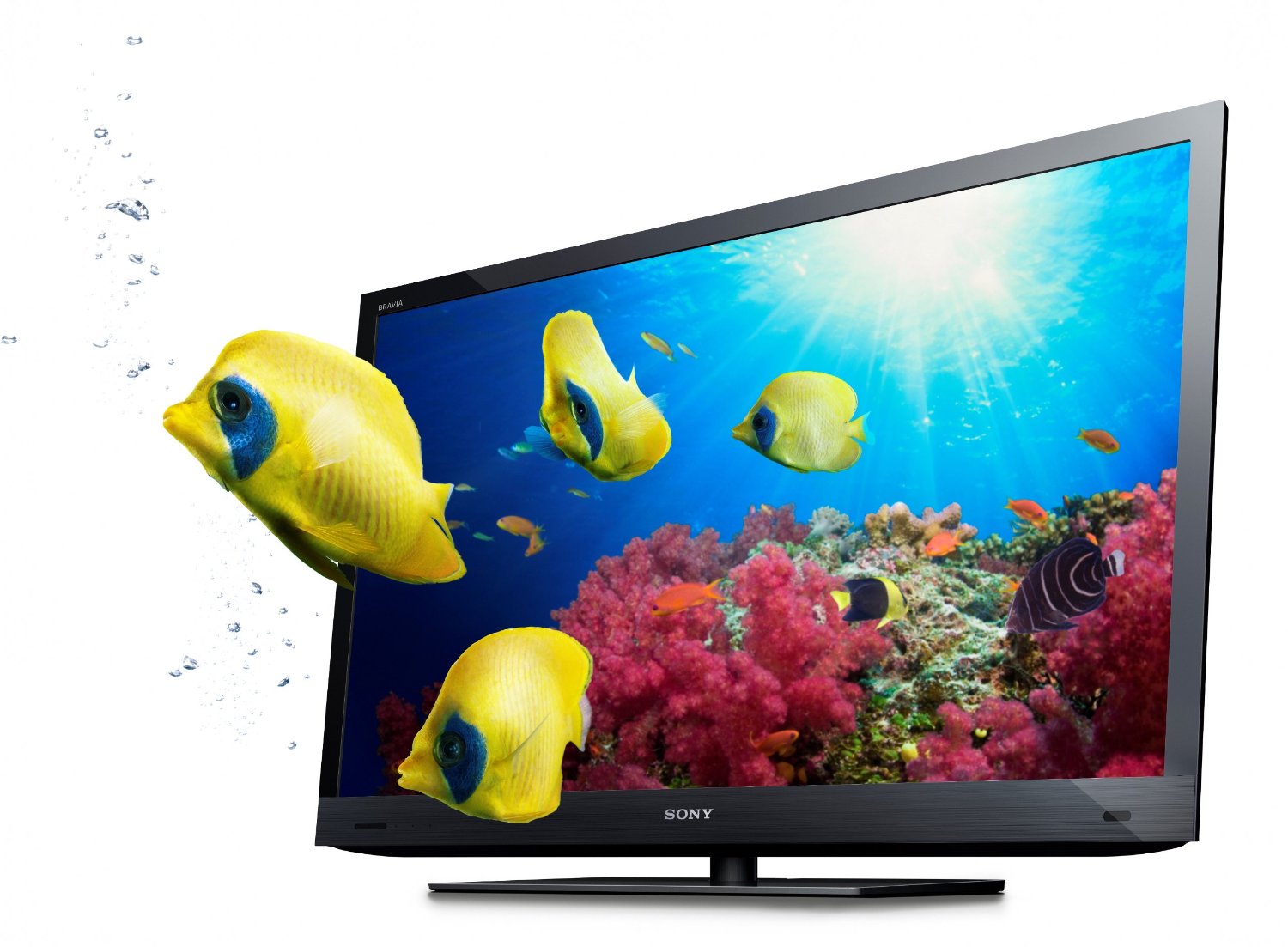
Today we will look at:
How to determine what type of cable is suitable for your equipment?
Each cable has a number of characteristics. This set may differ for cables used for different purposes.
Consider the device of a television cable.

There is nothing complicated in it:
conductor core in the middle;
an insulating layer around it;
shielding foil layer;
layer of shielding braid;
layer of outer insulation.
Characteristics of the conductive core
It is through a metal wire that a signal is transmitted that carries the image that you see on the screen.
Metal
There are many different opinions about the importance of the metal from which the vein is made. TV installers confidently state that for domestic use, cables with copper strands and copper-clad steel alloy strands give exactly the same result.
Core thickness
Cable diameter and core thickness are not always proportional values. The thickness of the core can be different, while the straight section of the cable without switching nodes with a thin core works in exactly the same way as with a thicker one. However, experts prefer cables with thicker cores - they are more reliable in operation, when you have to make many bends when laying the cable, use switching nodes.
Wave impedance
Such a characteristic as cable resistance directly affects the amount of television interference. To ensure a high-quality signal, it is necessary that the cable resistance be at least 75 ohms.
Shielding quality
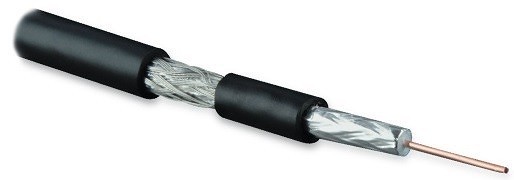
High quality cables are shielded with a double layer, first aluminum foil, then copper winding. Double shielding can significantly reduce the amount of interference. TV installers and repairers note that replacing an old single-shielded cable with a double-shielded cable can significantly improve picture quality.
External insulation
As a rule, television antennas are installed on the roof of the house or on the balcony, so part of the cable will be outside under the influence of external conditions. Therefore, it is recommended to choose a cable with a durable and high-quality insulating coating that can be used outdoors.
Cable size
When calculating the size of the cable, it is necessary to take into account all the bends and turns of its future laying. It is important to remember that the cable should not be taut. Therefore, after measuring the length of the cable path, it is advisable to add a little in reserve. A thinner cable is easier to bend and camouflage in the interior. But, on the other hand, thin cables fail faster: they bend more easily, fray, and at some point the core breaks.
Manufacturer and cost
Without experience, it is sometimes difficult to determine how well the outer insulating layer of the cable is made, not to mention its internal characteristics. Therefore, many are guided by cost and country of origin. Cheap Chinese products very often turn out to be not of the best quality, and sometimes do not correspond to the characteristics declared by the seller. Professionals prefer cable products from European countries or famous brands.
How to determine its characteristics by the type of cable
On high-quality cable products, all the necessary information is applied to the cable itself. The marking indicates the logo or name of the manufacturer, the brand of the cable, the magnitude of the wave resistance, diameter and other characteristics. Such marking is affixed approximately every meter.
Following the above recommendations, you can easily purchase a TV cable good quality and fully enjoy.
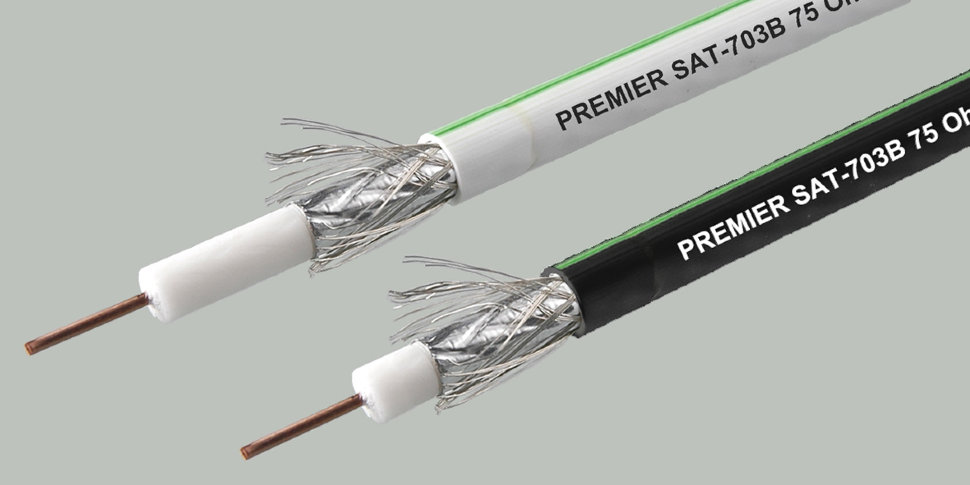 What is the best TV cable? SAT 703 or RG 6? Reading such titles, it seems that only an experienced specialist can understand the question. However, do not be afraid ahead of time. This article will help you understand the differences between the RG 6 cable and the SAT 703 cable and simplify your further selection in the store.
What is the best TV cable? SAT 703 or RG 6? Reading such titles, it seems that only an experienced specialist can understand the question. However, do not be afraid ahead of time. This article will help you understand the differences between the RG 6 cable and the SAT 703 cable and simplify your further selection in the store.
The main purpose of both cables is to transmit a signal from its source, for example, an antenna, to a receiver, that is, a TV. The better the connection, read cable, the better the picture will be. SAT 703 and RG 6 are the best options, according to experts.
TV cable RG-6 has internal insulation made with polyethylene foam, equipped with a double screen. Inside there is a steel conductor with a copper coating. Foamed polyethylene acts as a dielectric. External wiring is made of tinned copper wire and PVC sheath. Feature of the cable - the ability to operate in the frequency range up to 2 GHz.
The SAT 703 television cable is very similar to the previous counterpart. Some companies also make it with a copper-plated steel conductor, while others use copper exclusively. The former make low-quality cables, while the latter make high-quality ones. The RG 6 cable is not completely copper at all. The braid is also tinned copper with sheath. However, there is a special advantage: SAT 703 is preferred in cases of extreme cabling conditions. That is, such a cable can be mounted in any environment, because it has a very low coefficient of change as a result of external factors.
We have analyzed the technical side, now in more detail.
If you need to change or run a TV cable in the apartment to use the services cable television, for example, an RG 6 coaxial cable will suffice. To connect individual antennas, satellite dishes, in cases where the TV towers are very far away, and the cable length is expected to be significant, it is better to take SAT 703.
If your preference is the second option, then beware of a fake. When you go to the store, take a magnet with you. Any of the ones hanging on the fridge will work just fine. If you have a low-quality SAT 703 in front of you, then its conductor will be steel, which means it will be magnetized. If it is solid and made in good conscience, then it will not be magnetized, because magnets do not react to copper in any way.
Physical characteristics of the wire
Electrical characteristics of TV cable for TV
Varieties of TV cables
- Coaxial is the most common type of cable. Each TV is equipped with a connector for coaxial cables. But today this connecting element is considered obsolete, as more modern cables have appeared. Experts recommend using an analog antenna cable to connect home-type TV antennas, as the signal will be very reliable.
- Composite - used to attach video equipment (game consoles, players) to the screen. This wire is only suitable for analog signal transmission. The connection is made in accordance with the colors of the cords and connectors of the monitor.
- Component high-quality cable - a modern development, suitable for transmitting satellite TV signals. Connection also occurs in accordance with the colors.
- HDMI, DVI - designed to transmit a high-definition signal, such as digital television (TV), so if the TV equipment has an HDMI connector, then it is recommended to connect through it, since the quality of the broadcast picture will be ideal. And also HDMI and DVI cords are often used in computer technology to connect game consoles.
Choosing a quality cable for your TV is the most responsible event. Even the most advanced and modern signal source and correctly inserted plugs cannot guarantee a high quality image if the wrong cord is used. Therefore, the question arises of how to choose good cords for connection.
How to choose a quality TV cable?
For comfortable viewing of television programs, high-quality equipment is required, including connecting cables. When choosing the best wire, be sure to consider the criteria that determine the quality of the wire and guarantee reliable operation.
One of the important characteristics of a cord is its impedance. As a standard, its value should be at least 75 ohms, however, in our online store you can buy cords with lower resistance. The higher the value, the better the wire resists impact. different kind interference. The range includes options with a diameter of 4 and 6 mm. The thicker the cable, the less interference and distortion will affect its performance.
Structurally, the cable consists of a central core, insulation layers separating the screen layer and the central core, as well as protecting the TV cable from external influences. In modern wires, I use only a monolithic core. The cable in operation is not subjected to mechanical deformations, it is usually firmly fixed throughout the route. It is not economically feasible to make it flexible.
For outdoor use, it is better to ask about the resistance of the TV cable to low temperatures and ultraviolet. For a cable not adapted to such conditions, after a while the outer layer will become brittle, crack and eventually become saturated with water. There were times when water flowed into the room from the cable like a hose.
Choose a wire in which the central core is made of copper wire, with the insulation tightly pressed. And the foil has a copper braid. A cable with an average core made of an alloy of metals is allowed. Its advantages are low price. Compliance with these requirements allows you to get a high-quality image.
When calculating the footage of a television cable, all turns, ascents, descents and curvature must be taken into account. It is better to purchase a TV cable with a small margin. This will allow you to later rearrange the screen to another location.
When a long line length of 50 m and above is needed, suitable cords can be selected from the range of copper ones. This will play a role due to the low attenuation factor in a copper television cord.
Be sure to purchase high quality splitters and connectors for a high-quality antenna wire for a TV or a cable for a digital signal. It is not allowed to use homemade solderings and twists.
Popular Options
TV cords are available under different brands, below are the most common options:
RG-6U
RG-6U has the necessary characteristics and affordable price. The central core is made of copper. This wire is considered a worthwhile alternative to the obsolete PK cables. Suitable for connecting analog equipment, satellite.
The service life of RG-6U is 8 years, but when used outdoors, it often fails earlier. The advantage of this TV cable is that it can be freely purchased at any specialized store. The cost is from 8 rubles per meter.
SAT703
Reliable product, excellent TV signal transmission, suitable for satellite TV. Well withstands operation in outdoor conditions, as the cord is resistant to changes in weather and temperature.
The central core is copper, the wire is equipped with double shielding. Service life: 15 years. Price: from 18.5 rubles.
Cable DG 113
This option is more expensive than the previous wires. The characteristic presented by the manufacturer is almost identical to the SAT 703 wire, but there is one significant difference - DG 113 has a higher shielding factor, it starts from 90 dmb. Thanks to this, the quality of the TV signal is perfect, without interruptions and interference.
Service life: 10 years. Price: from 23.6 rubles.
- TV cable
For high-quality television broadcasting, not only the sufficient power of the incoming signal is important, but also the quality of the antenna wire. High-quality television cable will provide a powerful signal transmission without loss. Must choose correct wire for your TV to receive a strong enough TV signal to enjoy your favorite TV programs without interference.
Almost any wire for the antenna has a special marking. Here you can find basic information about the product.
Almost all television wires have the same design. The basis is the inner conductor (central core), which is covered with an insulating layer. A shielding layer in the form of a braid is located on top of the insulation. The construction is protected by a hard shell of insulation.
Cables with this structure are called coaxial.
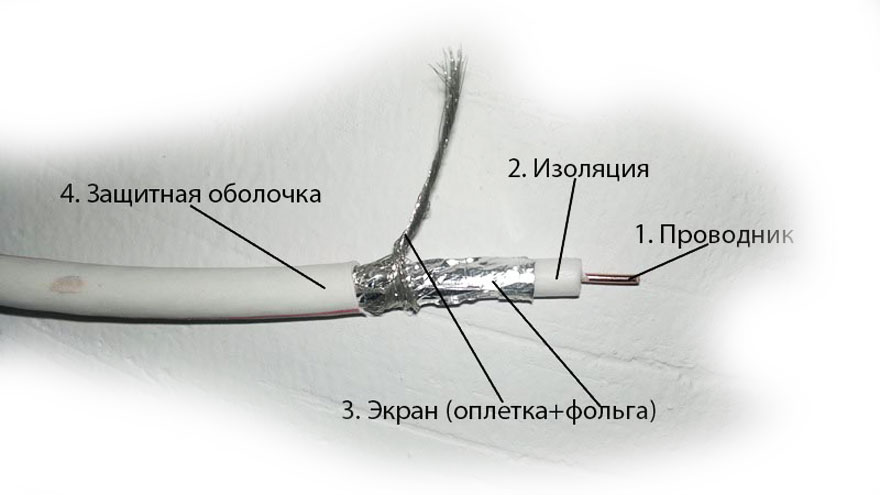
The high-frequency current of the television signal flows through the central conductor. The higher the frequency of the signal, the closer to the surface it will flow. This means that at high frequencies the current loss for cables of different sections will be the same. To reduce these losses, space technology uses a surface layer of gold to prevent signal loss.
For home use, copper or steel wires are used. To reduce signal attenuation, the steel core of the cable is covered with a thin layer of copper. A coaxial cable with a steel core is cheaper, but is not able to transmit a signal from a satellite dish without large losses.
A copper core transmits a television signal of any nature without problems, including a signal from a satellite dish.
The shielding layer or braid protects the cable from external electromagnetic interference. The quality of the TV signal directly depends on the strength of the interference.
The shielding layer is made of aluminum foil. The braid is made of copper or aluminum thin wire.
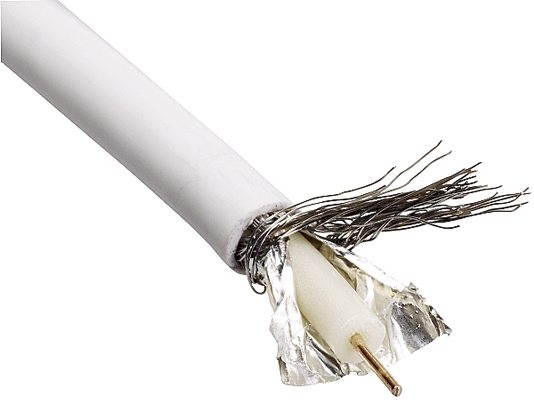
For a shielded wire, a value is defined, called the shielding factor, which describes the degree of protection of the cable.
The inner insulating sheath protects the inner conductor from damage and also insulates from contact with the screen. It is made from plastic. In particular quality wires PTFE is used.
The outer protective shell protects the structure from mechanical damage, dust, moisture, and other external influences. It is made of polyvinyl chloride, polyethylene, or other insulating materials.
Cable selection
When choosing a cable, you must be guided by some recommendations:
- Mandatory wave impedance of the television wire is 75 ohms. Cables with a different impedance are not compatible with the TV tuner and, as a result, cannot transmit a high-quality image.
- Choose a coaxial cable with a diameter of at least 6mm. Thinner cables are flimsy and easily damaged.
- The shielding factor of a good quality shielded wire is at least 60dB. To achieve the best degree of protection, it is better to choose a cable with a coefficient of at least 90 dB.
- Study the cable carefully. If the product has an unpleasant smell, or there is no marking on it, then you most likely have a fake.µ
- Try bending the cable. It should be easy to deform, but “wrinkles” should not appear on it. If they appear, then you have not the highest quality cable in your hands.

We present to your attention some brands and models of coaxial cables:

It is recommended to buy TV cables DG 13 - they are durable, reliable, and have many other advantages. If you are not able to buy such an expensive TV wire, then you can choose a cheaper option from the list.
For an overview of coaxial video cables, see below:
Compound
After purchasing a suitable cable, you need to connect it to your TV.
This stage is no less important than the choice of wire, since even the most expensive and high-quality product will not transmit a good signal if the connection is not made correctly.
Plug installation
It is advised to buy plugs from the same store where the cables are. Ask the seller to help you choose the right accessories.
The most common type of plug is the F-plug. It is designed to transmit both analog and digital television signals.
Connecting the plug to the antenna wire is very simple:
- With a clerical knife, make a circular incision of the upper protective layer to the screen shell a couple of centimeters long;
- After removing the outer sheath, carefully fold back the shield or sheath. Bend part of the foil again so that not the inner, but its outer part comes into contact with the plug;
- Remove the insulating sheath of the central wire;
- Put the plug on the cable and turn it clockwise until it stops;
- Cut off the excess strands.
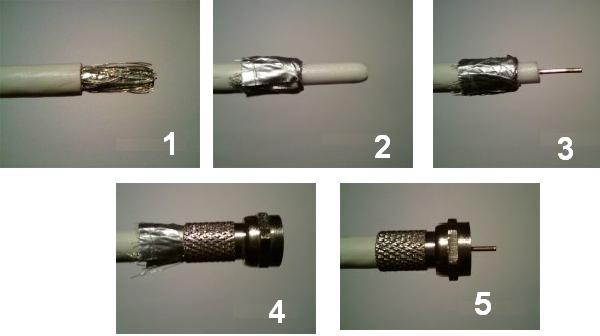
Plug installation is complete.
It is also useful to watch a video on how to connect a TV plug to a coaxial cable:
Sometimes the quality of the TV signal drops unexpectedly. In such cases, it is necessary to identify the causes of signal degradation and eliminate them.
- If the cable is damaged, first you need to find the place of the break.
Next, divide the cable into 2 parts and carry out the same operation with each of the parts as when putting on the plug. Buy special nozzles that are worn on the cable and connect the damaged parts. - The cable can be extended in the same way. It is recommended that you use a cable of the same brand and model for extension.
- Signal quality can also drop due to sharp turns in the TV wire.
Do not bend the cable sharply 90 degrees. Be sure to bend the cable with a certain radius.
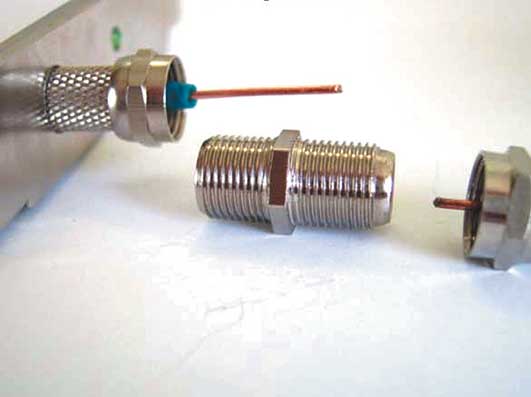
Be sure to watch the video on how to connect a TV cable:
Connecting multiple TVs
To connect several devices to one antenna at once, splitters are used, which are otherwise called "crabs".
How to connect multiple TVs to the same antenna via a video splitter:
Crabs are recommended for use in areas with strong TV signals, i.e. close to television towers, since when a crab is connected, the signal strength decreases sharply. For example, if you connect 2 TVs to one antenna, then the signal loss will be about 30%.
The number of outputs on the crab must be strictly equal to the number of connected devices. If there is a free exit on the crab, the signal quality will still fall.
Amplifiers
Amplifiers are used to amplify the TV signal.
The device should be close to the TV or to the antenna.
Most often, amplifiers are used to compensate for signal loss due to the use of crabs.
Connecting a TV to an antenna through a video amplifier:
As you can see, choosing and installing a good television wire for an antenna requires taking into account many nuances. But it's worth it, because right choice tv cable - broadcasting will proceed without interference. We hope that this article on television cables will help you make the right choice.





